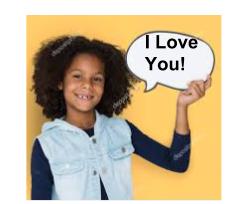February – the month of love; loving and caring for our family, our friends, our significant other. Don’t keep the love only in the month of February. Life gets in the way of the best plans. Set a small goal for you and your loved ones to communicate how much you love and appreciate each other (and others) on a more regular basis.
The suggestions made for wishing others a Happy Valentine’s day can be incorporated throughout the year. Change the message (ie: Get well; Have a great day; etc) or just sending love, not only helps your loved one practice communication skills but strengthens the bond between the well wisher and the recipient.
Start the ‘Star of the Month’ in your house. Choose one person – start with YOURSELF – and share some information your family may (or may not) know. Pick a special time – after dinner, during dinner, before bed – for the ‘Star’ to communicate a special something. The ‘Star’ can share favorite foods, places, colors, animals. The ‘Star’ can share a favorite memory or story. For loved ones that communicate using alternative means, use a basic communication board or basic signs to share this information. Use a family picture to communicate a favorite story or memory. Use labels from favorites foods to communicate that information to the rest of the family. The ‘Star’ practices communicating effectively and everyone learns more reasons to love and appreciate the ‘Star’.
Communicate love and appreciation at lunch. Put a ‘love note’ to your loved ones lunch boxes, backpacks, or briefcases. A little reminder mid-day that someone is thinking of them and wanting their day to be special. These ‘love notes’ do not need to be complicated or even in written form for that matter. Search for and print out pictures of favorite cartoon characters or superheroes and just put them where your loved one will see them. Blot lipstick on a piece of paper and send a ‘kiss’ to your loved one – no words necessary. Cut a napkin in a heart and/or buy special character napkins to include in lunches every once in a while.
No matter your age, communicating a simple ‘I’m thinking about you’ message makes the day better and brighter.
Yours in Speech,
Lakeshore Speech Therapy, LLC.















